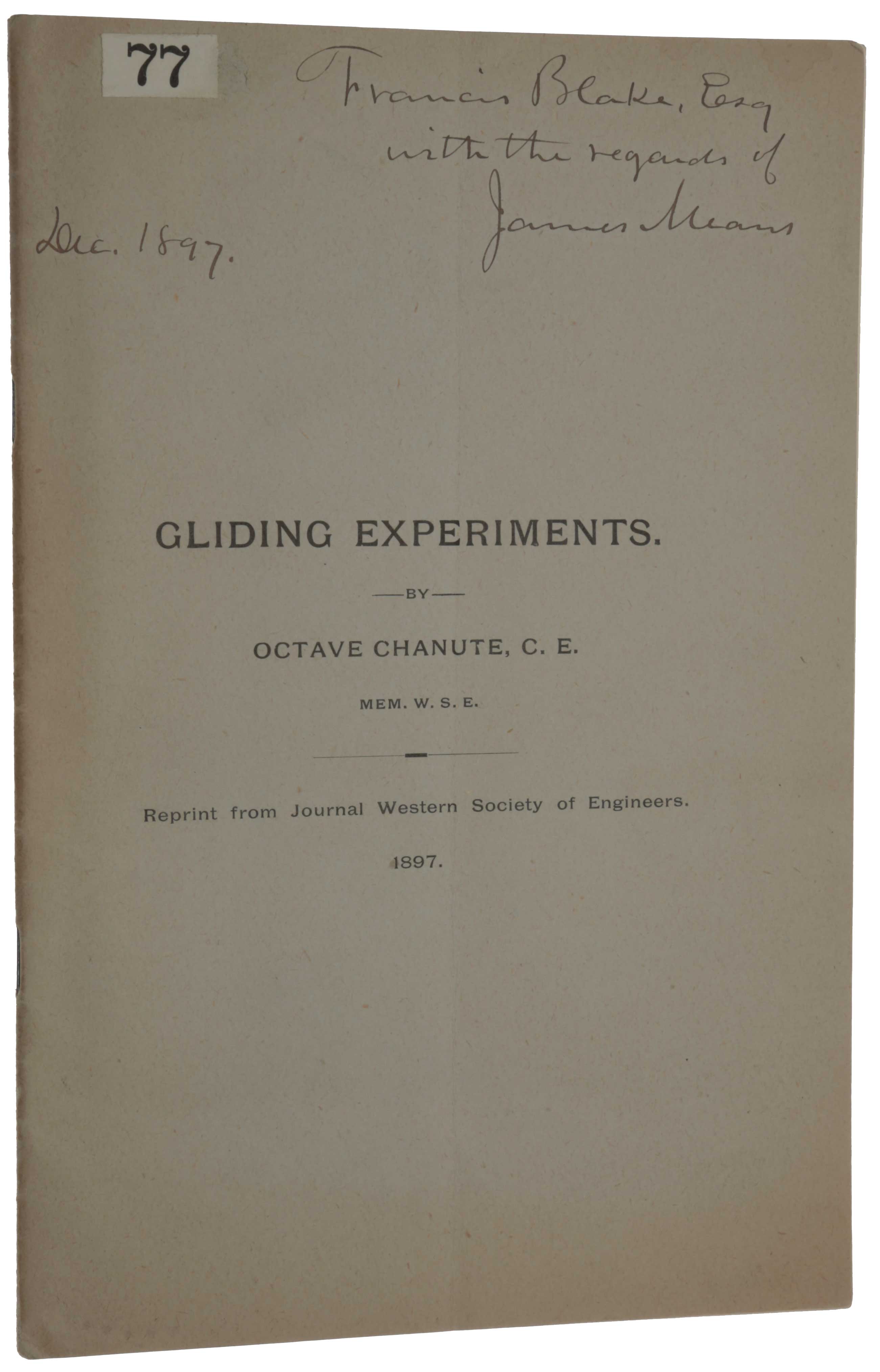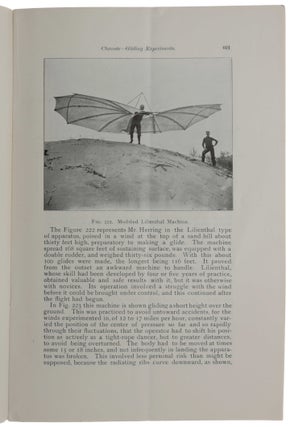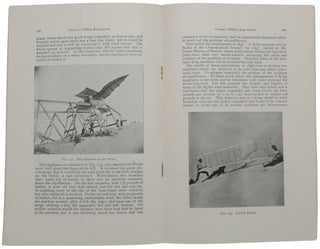Gliding Experiments. Offprint from: Journal of the Western Society of Engineers, Vol. 2, No. 5, October, 1897 (read 20 October).
[Chicago: Western Society of Engineers], 1897. First edition, extremely rare offprint, of this seminal work in the history of aviation, and a remarkable association copy linking three great early American pioneers of aviation and technology. In this work, Chanute presented his findings from nearly 2,000 flights made at Dune Park, Indiana, on the shores of Lake Michigan, in the summer of the previous year. These test-flights, led to his introduction of the Pratt-trussed biplane configuration, the essential shape of the early airplane, which was later adopted by the Wright brothers, and which he described in the present article. “It was a pivotal moment in the history of aircraft design, ranking with Henson and Stringfellow’s postulation of the Aerial Steam Carriage over half a century earlier and Cayley’s even more distant derivation of the modern airplane shape. It ushered in an era of strong, light, straightforward, uncomplicated (and easily analysed) rectangular structures that quickly superseded the convoluted curves and framing of older attempts such as those by Adler and Lilienthal. Chanute, in short, had taken both glider experimentation and structural design to a new level, contributions of seminal importance” (Hallion, p. 177). “The Chanute glider, designed by Chanute but also incorporating the ideas of his young employee Herring with regard to automatic stability, was the most influential of all flying machines built before the Wright brothers began designing aircraft … Wilbur Wright, whom Chanute befriended, understood the importance of the 1896 biplane glider. ‘The double-deck machine,’ Wright remarked, ‘represented a very great structural advance, as it was the first in which the principles of the modern truss bridge were fully applied to flying machine construction.’ Chanute’s rigid, lightweight structure provided the most basic model for all externally based biplanes. It was nothing less than the first modern aircraft structure” (Britannica). “The Wright brothers began their long association with Chanute in 1899, when they started serious work on their airplane. The Wrights corresponded with Chanute regularly, carefully detailing their thoughts to him. He served as their mentor, encouraging their efforts and offering advice. In 1901 he visited the brothers and encouraged them in their gliding experiments. Chanute also witnessed the early Wright flights, including the 1902 glider and the 1904 and 1905 powered flyer. He published the Wright brothers’ writings in America and abroad, which did much to stimulate interest in aviation” (Octave Chanute and His Photos of the Wright Experiments at the Kill Devil Hills, www.memory.local.gov). OCLC locates eight known copies, including those at the Library of Congress and the Smithsonian. No copies on ABPC/RBH. Provenance: James Means (1853-1920), industrialist and aviation pioneer, inscribed on front wrapper to: Francis Blake Jr. (1850-1913), engineer and inventor who partnered with Alexander Graham Bell in the invention of the telephone (see below). “Born in 1832, the son of a history professor at the Collège de France, [Chanute] emigrated with his parents to the United States at age six, where his father assumed the vice presidency of Jefferson College in Louisiana. Though he considered himself American, young Chanute grew up in an intellectually oriented household so European in outlook that a pronounced Gallic accent would forever tinge his English. Gifted in mathematics, he chose a career in engineering while still a teenager, subsequently joining a railway survey crew and learning engineering first-hand. He eventually rose to the very top of his profession, earning a fortune while working with a series of railroad companies, as a noted bridge builder, and as the architect and chief engineer of the Union Stock Yards in Chicago and Kansas City … But Chanute harboured a dark secret, something he feared that if learned could hurt his reputation: he had accumulated a wealth of material on early flying attempts, paths taken, and configurations chosen. He was in fact a closet aerophile, had been since taking a trip to France with his wife and children in 1875 that had exposed him to the work of Pénaud, Wenham and others, and in a few more years, he hoped, he might be able to come out in the open … “Only when in his late 50s, so distinguished, accomplished, and professionally secure as to no longer fear ridicule for advocating and discussing aviation, did he now devote his full attention to flight. And he did so with the characteristic energy and enthusiasm he had brought to his career as a practicing engineer. He became a virtual one-man aeronautical information clearinghouse and also bankrolled a number of individuals studying aviation … Upon Chanute’s death in 1910, Wilbur Wright would state: ‘No one was too humble to receive a share of his time. In patience and goodness of heart he has rarely been surpassed. Few men were more universally respected and loved.’ “In 1891 he wrote the first of a series of articles for American Engineer and Railroad Journal, which he would pull together and publish as a book three years later. He also sponsored professional meetings, most notably a four-day international Conference on Aerial Navigation held in Chicago on August 1-4, 1894, that drew together most of the major names in American aviation, and some international figures as well … “Chanute clearly enunciated his own thoughts on flight in his address at the opening of the conference. Flight to this point, he said, ‘has hitherto been associated with failure,’ its advocates viewed ‘as eccentric – to speak plainly, as ‘cranks’’. But the record of ballooning and airship development, and now increasingly that of winged aviation, held great promise, even if the precise commercial and military promise of such craft could not yet be clearly seen. Most significant, Chanute emphasized the importance of seeking integrated solutions to the problems of flight. ‘It is a mistake,’ he wrote, ‘to suppose that the problem of aviation is a single problem. In point of fact, it involves many problems, each to be separately solved, and these solutions then to be combined. These problems pertain to the motor, to the propelling instrument, to the form, extent, texture, and construction of the sustaining surfaces, and to the maintenance of the equipment [i.e., stability], to the methods of getting under way, of steering the apparatus in the air, and of alighting safely. They each constitute one problem, involving one or more solutions, to be subsequently combined.’ Chanute’s own book, Progress in Flying Machines, appeared shortly after the conference concluded … “In 1895 Chanute turned away from merely reading and writing about aircraft to actually designing them, working with Augustus Herring, a well-to-do Georgian who experimented with copies of Lilienthal gliders … At first Chanute had looked at simply improving upon Lilienthal’s work, going so far as to file a patent application for a derivative of his Normal-Segelapparat … But Chanute had a more practical structural outlook than any of the other pre-Wright pioneers who attempted actual aircraft, including Lilienthal, and after reconsidering, quickly abandoned Lilienthal’s design concept. Since prevailing thought emphasized very thin wing sections and a birdlike platform (the shape of the wing when seen from above), a major challenge for all these individuals was furnishing sufficient rigidity and strength and ensuring that it retained its aerofoil shape and overall platform without distorting under the loads it experienced in flight. For example, Lilienthal chose multiple wing spurs of varying length radiating from a tall central post (somewhat in the fashion of an open umbrella) with wires connected from the top and bottom of the post to the ends of each spar. Chanute took a very different approach, favouring multi-wing designs having stacked wings one above the other, based on his experience building bridges, where the interconnected wings and struts acted like a reinforcing truss. “Trusses were something that Chanute knew a great deal about. The introduction of iron had revolutionized building and bridge construction in the nineteenth century. In the early 1840s, building upon earlier wooden truss designs of William Howe, Caleb Pratt and his son Thomas patented a new design for an iron truss bridge that used regularly spaced vertical posts under compression connecting upper and lower deck frames. Within each ‘bay’ formed by the posts, a pair of diagonals held in tension imparted further rigidity and stability to the structure. The geometrically clean and logical Pratt truss enabled straightforward calculation of loads and load distributions and quickly became one of two dominant bridge forms in America … “When Chanute began building his own glider he adopted a ‘multi-wing’ platform, using the Howe truss as the key structural concept … Chanute’s glider had no fewer than 12 separate wings arranged in six pairs. This machine, informally called the Katydid because it resembled a giant insect, had these wings ingeniously pivoted where they joined the main frame (there was no ‘body’ or ‘fuselage’ per se) so that if a gust hit the glider, the wings would be blown backwards a foot or two until wires with restraining springs prevented their further movement. Thus the wing could automatically compensate for changes to the center of pressure without requiring extraordinary – and perhaps futile – body movements by the pilot … “But Chanute’s Katydid did not go well, as the multiple wings and profusion of bracing struts and wires created a great deal of retarding drag, and the automatic wing pivoting feature proved less useful than hoped … so Katydid undoubtedly was a troubled design. But another concept offered great promise: a Chanute-Herring collaboration, a ‘three-surface’ glider – that is, a triplane – with non-pivoting rigid wings trussed together to provide the necessary strength and rigidity. “This glider proved an important design for several reasons. First, it had a very simple, uncomplicated, straight-line structure (anticipating the design of the Wrights’ own aircraft a half decade hence) in contrast to virtually all previous gliders (by Chanute, Lilienthal, and others), which had generally adopted the curvaceous lines of birds or bats. Second, in contrast to Katydid’s awkward multi-plane design, it had just three wings, superposed one above the other, rectangular in platform and equivalent in span and chord. Chanute and Herring cut away the center section of the lower wing so that the pilot could control the craft by shifting his body around. Finally, the glider featured a tail boom ending in a Herring-designed self-adjusting, spring-loaded cruciform tail (which Chanute called a ‘combined horizontal and vertical rudder’) to give the craft automatic and self-restoring stability, no matter what the wind conditions. In short, it was a crisp, clean, logically thought-out, and altogether practical craft that at once signaled Chanute and Herring’s mastery of design, even beyond that of the venerated Lilienthal, and certainly beyond any of his predecessors. “Chanute had to delay trials of this craft, for a violent storm wrecked his little camp in the morning of Friday, August 21, 1896, and caused much damage. Repairs to the camp and the gliders occupied the next week; on Saturday, August 29, Avery and Herring began testing this glider, not quite three weeks after Lilienthal’s demise. While it flew very well, when banking or inclining close to the ground the lower wing tended to strike the surface. Trials to date had clearly shown the glider had excellent lifting characteristics, so Chanute simply removed the lower wing. The result was a ‘two-surface’ machine – that is, a biplane – now perfectly Pratt-trussed: the essential shape of the early airplane. “Best of all, it flew superbly, gliding over 350 feet in 14 seconds with a reasonably good gliding descent of 5.75:1; that is, nearly six feet forward for every one foot in vertical descent. It had none of the skittish and potentially fatal quirkiness of the Lilienthal type. As Chanute recalled: ‘During the next 14 days scores and scores of glides were made with this machine, whenever the wind served. It was found steady, easy to handle before starting, and under good control when underway – a motion of the operator’s body of not over two inches proving as effective as a motion of five or more inches in the Lilienthal machine.’ “Thus, thanks to a fortuitous series of circumstances – his background as a bridge builder and his knowledge of truss design, the problems with the Katydid, Herring’s influence, the beguiling simplicity of the alternative triplane approach, the problems with snagging the lower wing against the ground – Chanute gave the Pratt-trussed biplane configuration to aviation” (pp. 170-177). “The friendship between Chanute and the Wright brothers began on 13 May 1900, when Wilbur Wright wrote to the famous engineer, introducing himself as someone ‘afflicted with the belief that flight is possible to man.’ It was the first item in what would become the most significant correspondence in the early history of aviation. Between Wilbur’s first letter and Chanute’s death in May 1910, 435 letters or telegrams would pass between them. Chanute and the Wright brothers ultimately found it very difficult to agree upon the nature of their relationship, or the precise impact of the older engineer on the work of the two brothers from Dayton. There can be no doubt, however, that Octave Chanute was the Wright brothers’ single most important friend and correspondent in the larger aeronautical community” (Octave Chanute and His Photos of the Wright Experiments at the Kill Devil Hills, www.memory.loc.gov). Chanute’s Progress in Flying Machines “appeared but a year before another notable compilation, the first of Bostonian James Means’s three-volume Aeronautical Annuals. Like Chanute Means was wealthy and had a fascination with flight and a keen appreciation for significant work, but unlike Chanute, Means himself was a businessman, not an engineer or technologist, and he was younger by over 20 years. Strikingly good-looking with a distinguished, reserved air, James Means was the epitome of the successful Yankee entrepreneur. Descended from old Massachusetts Bay pioneer stock – his father was a Congregationalist minister in Dorchester – he had attended local schools, the Phillips Academy at Andover, and the Massachusetts Institute of Technology, before leaving school to start a wildly-successful shoe-manufacturing business. Selling cheaply manufactured but very high quality shoes at a very low price proved so profitable that he was able to retire to pursue his own interests at the age of 40 in 1893. And chief among his interests was flight, an interest triggered in 1879 when as a 26-year old he watched soaring gulls from the deck of a paddle-wheel steamship, the SS Constitution, slowly making its way from Panama to San Francisco on its last voyage before going to a breaker’s yard. “Means wrote widely and perceptively on aviation himself, even anticipating the era of precision-guided aerial munitions and cruise missiles 30 years before their appearance in rudimentary form in the midst of the Second World War, and not quite 100 years before their deadly effectiveness would shock observers world wide during the Persian Gulf War. He was far less successful as an inventor. But where Means shone was – like Chanute – as an aerial clearinghouse. Together Chanute and Means assembled a tremendous aeronautical database for the use of other researchers. Chanute’s Progress and Means’s Annuals have been likened (not without justification) to the Old and New Testaments of the Bible: the former constituting the historical record and the latter the state of current work … He ceased issuing the Annuals after 1897 because he received too little good material and the cost of publication was becoming excessive. But he followed aviation assiduously, journeying to Ft. Myer in 1908 to watch Orville Wright demonstrate the first Military Flyer … He died in 1920 at the age of 67” (Hallion, pp. 173-4). The recipient of this offprint, Francis Blake, “was born in Needham, Massachusetts, the son of Caroline Burling (Trumbull) and Francis Blake, Sr. and died in Weston, Massachusetts. In 1877 Francis Blake invented a carbon microphone for use in the telephone, and patented it before Thomas Edison invented a similar microphone that also used carbon contacts. Blake used a carbon button design that initially would not stay in adjustment, but with later improvements proved to be workable. Alexander Graham Bell hired Blake and put him to work with Emile Berliner who also invented a carbon microphone. The improved Berliner-Blake microphone was standard with the Bell company for many years” (Wikipedia). Randers-Pehrson & Renstrom 114. Hallion, Taking Flight. Inventing the Aerial Age from Antiquity through the First World War, 2003.
In that seminal on 13 May 1900 first letter from Wilbur Wright to Chanute, Wright acknowledged that he had read of, and was inspired by, Chanute’s experiments at Dune Park, detailed in the present offprint: “... I will proceed to describe the plan and apparatus it is my intention to test. In explaining these, my object is to learn to what extent similar plans have been tested and found to be failures, and also to obtain such suggestions as your great knowledge and experience might enable you to give me. I make no secret of my plans for the reason that I believe no financial profit will accrue to the inventor of the first flying machine, and that only those who are willing to give as well as to receive suggestions can hope to link their names with the honor of its discovery. The problem is too great for one man alone and unaided to solve in secret … In the apparatus I intend to employ I make use of the torsion principle. In appearance it is very similar to the ‘double-deck’ machine with which the experiments of yourself and Mr. Herring were conducted in 1896-7.”
8vo (235 x 157 mm), pp. [593]-628, with thirty-one half-tone photographic illustrations. Original publisher’s printed wrappers. Light vertical crease from having been folded for postage. A very fine copy.
Item #4699
Price: $15,000.00





